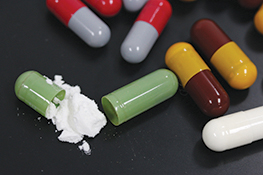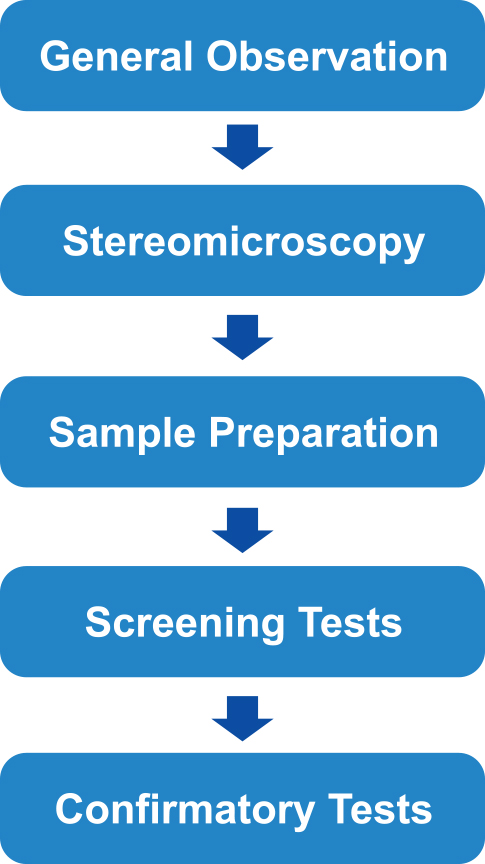What are Unknown Chemicals and Materials?
Of the millions of chemicals that exist in the world today, tens of thousands are commercially available in various forms and formulations for industrial, household, medical and other uses. The abundance and ubiquity of many of these substances provide a virtually limitless supply of chemicals and materials with the potential to be unknown substances associated with a civil or criminal case.


As implied by its name, the unknown substance has properties, chemical composition and/or origin that are unclear or unknown. The definition of an unknown substance is at times related to that of trace evidence,1 especially for cases where the evidence is present in trace amounts.
The unknown may be in the form of a solid, liquid or gas, or a mixture comprising two or more of these forms. It may be present in bulk or in trace amounts, be as subtle as a whiff of a flammable liquid at a fire scene or as obvious as the drums of white powder at a make-shift counterfeit drugs factory. The unknown may be natural or man-made, consist of a single pure compound or a complex concoction comprising multiple components. The expertise and ingenuity of the forensic scientist is often challenged in the examination of such a diverse range of chemicals and materials.
Purpose of Analysis
An unknown sample is typically submitted to the forensic laboratory for one or more of the following:
1. Identification (qualitative determination)
• What is the identity of the unknown?
• Is it a pure substance or a mixture?
2. Comparison with a sample from a known source. In tandem with the identification of an unknown substance recovered from a scene or victim, an apprehended suspect may be found to possess a suspicious substance which visually resembles the unknown substance. Characterisation of this substance and comparing it with the unknown sample may provide vital links between the suspect, victim and scene.
• Is the unknown similar to the known sample?
• Could they have originated from the same source?
3. Quantitation. Most of the requests for the analysis of unknowns are qualitative in nature. In some cases, the amount (percentage composition) of the components of a mixture may be required. Quantitation of a specific substance is performed after identification.
• How much of substance X is present in the unknown sample?
4. Provision of important investigative leads
• Where did the unknown substance originate from?
• What is it used for?
• Who has access to such a chemical or material?
• Is it a precursor, by-product or end-product of a chemical process or reaction?
Occurrence of Unknowns
Unknowns are commonly encountered in robbery, assault, homicide, suicide, fire, explosion, criminal intimidation, vandalism, drug trafficking, hoax, counterfeiting, poisoning and adulteration cases. Unknowns in the form of impurities, contaminants and unexpected by-products may be encountered while troubleshooting non-compliances in industrial quality assurance operations and manufacturing processes.
Samples commonly submitted for analysis include unknown powders, liquids and mixtures, items with unknown residues and stains or unknown solid particulates in liquid. Listed below are some common scenarios where unknowns were encountered, with the evidential value of their identification and comparison highlighted.
Unknown solids may be in the form of powders and particulates. Examples include:
• white powder in an envelope containing an anthrax threat letter;
• small amounts of white powder left at a suspected drug trafficking scene;
• black disc-shaped smokeless powders in the remnants of an exploded device;
• orange-coloured chilli powder on the inside of a trousers pocket of a robbery suspect;
• small paint fragments adhering to an improvised scraper found with a person suspected of vandalism against vehicles.
For many of these cases, identifying the unknown solids provides crucial investigative leads and associations between the victim, scene and the suspect, and ascertains whether any criminal activity was involved. In other cases such as the spate of anthrax hoaxes, identification of a benign household material conferred peace of mind to the victims, and helped determine whether two or more of the anthrax cases could be associated with each other and traced to a common origin and suspect.
Unknown liquids range widely from suspicious consumer products such as the solution inside a pack of counterfeit contact lenses to a few millilitres of suspicious liquid found next to a deceased at a scene of death. An unsuspecting victim could have been splashed with or sat on a pool of unknown liquid which subsequently caused serious chemical burns to the skin. In cases where actual harm was intended, these liquids are usually strong mineral acids which are capable of causing first degree burns to human skin. At a fire and/or explosion scene, the liquid left in a partially burnt bottle may be identified as containing ignitable liquids such as petrol, kerosene or thinner. In the raid of a clandestine laboratory, bottles of unknown liquids and tubs of crystalline solids need to be identified to determine their safe handling and disposal procedures, as well as the intent of synthesising these chemicals and the legal implications associated with the intent.
Unknown gases are usually encountered in cases involving fire and explosion, gas intoxication and asphyxiation. For example, the gas composition in a scuba cylinder related to a fatal diving incident.
Two other types of crime involving unknown chemicals and materials are adulteration and tampering. Beverages such as milk, soft drinks, water or food which appear, smell or taste strange may have been adulterated. Adulterants are often easily available household products such as insecticides, detergents or acids. Drugs may also be spiked into alcoholic beverages in drug-facilitated sexual assaults. In tampering cases, security labels may be cut and the cut ends subsequently joined back using adhesives. Additional numerals and letters may be written with ink of similar
colour to alter the original monetary value on tampered cheques.

Identification of unknowns are also encountered in day-to-day quality control operations. For instance, identification of the contaminants in a pharmaceutical tablet allows the manufacturing plant
to home in
on malfunctioning processes and rectify the problem to restore product quality. Product recalls may be required if prohibited chemicals are found in commercial products. The presence of a clump of fibres in a clean room could prompt management to quickly identify the source of the fibres.
Laboratory Analysis of Unknowns
Like all matter, every unknown substance has a characteristic set of physical and chemical properties. Forensic scientists employ scientific techniques to determine these characteristics in order to elucidate the identity of an unknown substance. Familiarity with the properties of a broad range of chemicals and materials, coupled with knowledge of a wide spectrum of analytical techniques enables the forensic scientist to determine the best analytical approach for a given type of sample.


Identification of an unknown: The identification of an unknown substance follows a systematic approach involving five key stages (See Figure 1):
1. General Observation: Information on the packaging, state of sample, quantity of sample present and any obvious odour are documented.
2. Stereomicroscopy: Examination under a stereomicroscope of a solid sample can provide information on its morphology (eg crystalline or amorphous), physical characteristics (eg hard, soft, brittle or elastic) and whether it is a mixture or pure substance.
3. Sample Preparation: Samples which are relatively pure are usually sampled directly for analysis. Target substances which cannot be directly sampled are extracted from the sample medium and pre-concentrated for testing.
4. Screening Tests: These are presumptive tests which are less precise but provide a quick insight into the likelihood of the unknown being a particular substance or belonging to a family of substances. These tests are usually colorimetric, involving a colour change if the substance is present, for example, pH range using litmus paper for acids or bases, and Kastle-Meyer test for the presence of blood. Any positive result from a screening test is tentative at best and must be verified by a confirmatory test. Screening tests are useful for elimination, and facilitate the selection of appropriate confirmatory tests to identify the unknown substances.
5. Confirmatory Tests: Confirmatory testing utilises analytical techniques to identify the contents of a sample. This often requires a multi-step process to separate the individual components, determine their chemical characteristics and compare them against reference standards or information from chemical databases to make an identification. (Note: Reference standards are substances of known identity, purity and concentration.) Other than qualitative analysis, these tests may also include quantitative analysis of the sample where the amount and purity of the sample are determined.
Confirmatory tests involve a battery of analytical techniques which are broadly classified into a few categories:
1. Spectroscopic techniques which identify a substance by its selective absorption or scattering of different wavelengths of light, eg Fourier Transformed Infrared Spectroscopy (“FT-IR”), Raman spectroscopy.
2. Chromatographic techniques which separate and identify based on retention times the individual substances in a mixture, eg Gas Chromatography (“GC”), Liquid Chromatography (“LC”) and Ion Chromatography (“IC”).
3. Elemental techniques which identify a substance by its characteristic X-rays, eg energy dispersive X-ray (“EDX”), X-ray fluorescence (“XRF”).
4. Mass spectrometry which characterises and identifies the substances present in a sample through its chemical fingerprint.
Comparison with a sample from a known source: In most cases, especially for those requiring comparison, the forensic laboratory will require the submission of both the comparison and control samples. For example, in a sexual assault case where the unknown was a can of XYZ beer suspected to be adulterated with midazolam, a similar can of unadulterated XYZ beer (control sample) is submitted as a control sample to understand the medium (XYZ beer). This will facilitate the extraction process of midazolam. If some suspicious tablets (comparison sample) are subsequently found in the possession of the suspect, the chemical composition of these tablets will be examined for midazolam. The chemical ingredients present in trace amounts can also be compared with the unknown sample to determine whether the adulterant could have originated from these tablets.
Challenges and Pitfalls in the Analysis
of Unknowns
To obtain reliable findings, the scientist must ensure that the techniques employed are scientifically justified and appropriately validated. It is vital for the scientist to understand the analytical limitations of the methods selected for examination. Different combinations of techniques are required for the analysis of different types of substances.
Some of the challenges encountered in the analysis of unknowns include the following:
1. Most substances are complex mixtures, making it difficult to identify all the components in the mixture and to determine when it is appropriate to identify something specific (eg milk powder) and when to be generic (eg a mixture containing mainly carbohydrate and protein).
2. Different product lines and formulations with various end-purposes may have nearly the same set of ingredients. Hence, care must be taken to include appropriate qualifiers in the report to highlight the non-uniqueness of the chemical compositions.
3. Samples may degrade or their chemical compositions may alter with time, eg metals may oxidise or corrode. Food substances may decay or decompose. Certain plastic materials age and may turn yellow.
4. Interferences from a complex medium often result in difficulty in extracting the target substances from the medium.
5. Adulterants are often present in trace amounts, adding to the difficulty in their isolation and detection.
6. The chemical composition of heat sensitive samples may alter in the instrument due to degradation.
The interpretation of laboratory findings, and the level of conclusion in the forensic report will depend on factors such as:
1. the type and combination of screening and confirmatory tests performed;
2. the availability of suitable controls and comparison samples, reference standards and information from chemical substances;
3. the degree of match between the chemical fingerprint of the unknown with the known fingerprint residing in the instrument’s library of substances; and
4. knowledge of the sample medium and possible background interference.
Local Cases Involving Unknowns
Unknown chemicals and materials have been encountered in a myriad of cases. Some examples of criminal and product liability cases which had been handled by our experts are highlighted below.
Anthrax hoaxes 2
Following the anthrax scare in America, a spate of cases involving “anthrax”-laced threat letters was encountered locally over several months. In some cases, the person who opened the letter fainted upon smelling the white powder inside the envelope, intensifying the anxiety, confusion and fear already associated with these cases. The white powders in the envelopes were found not to be anthrax but benign household materials such as talcum powder, flour, detergent and glucose.
“Acid” on MRT seat 3, 4
A nurse was taking the MRT home when she sat on a seat without noticing the liquid on it. Her left buttock suffered burns similar to those caused by corrosive substances. The liquid was analysed and found to contain sodium hydroxide, which is listed in the First Schedule of the Corrosive and Explosive Substances and Offensive Weapons Act (Chapter 65). A man was subsequently arrested for negligent act causing hurt involving unknown substances.
Counterfeit contact lenses (PP v Koh Peng Kiat) 5, 6
CIBA VISION was first alerted to the counterfeit contact lenses being sold in optical shops in Singapore when it received stocks of “FreshLooks®ColorBlends®” contact lenses for exchange from several optical shops. Laboratory examination of the counterfeit products found that their packaging and chemical ingredients differed from those of the authentic products. They were unsafe, of poor quality and deficient in many aspects.
Chlorine smell in the filling of cakes and pies7
Sabotage was cited by the owner of a bakery after ingredients for its best-selling cakes and chicken-mushroom pies were found reeking of chlorine. The bakery’s factory was shut down by the authorities after staff discovered the source of the contamination. Chemical analysis of the cakes and pies identified a bleaching agent as the likely contaminant.
Contaminants found in Zerin tablets8
Post marketing surveillance led to the suspension of Zerin® tablets in 2011 due to product defects. Small foreign particles were found in some tablets from different batches. Although the foreign particles were found to be inert, non-toxic substances which pose minimal risk to consumers, sales and distribution of the tablets were discontinued to prevent the public from being exposed to a product which was not compliant to quality standards.
Recall of hot/cold gel packs containing a toxic substance9
A recall of a hot/cold gel pack in Australia following a case of accidental poisoning in a young child who ingested the contents of a hot/cold pack prompted our local authorities to investigate similar products in Singapore. Hot/cold packs were voluntarily recalled after laboratory tests revealed that similar to the Australian case, some of them contained the toxic ethylene glycol which is prohibited for use in hot/cold packs.
Tainted toy causes poisoning amongst school children10
An incident involving the mass vomiting of 17 primary six students from a primary school in Singapore was reported to the Ministry of Health (MOH). Investigations by the MOH indicated that the students had earlier been in contact with an “Extrusion Bean” toy and had not washed their hands properly prior to consuming food in school. Laboratory tests showed the presence of toxic chemicals on the toy. MOH subsequently urged consumers who owned the toy to discard it.
Conclusion
Unknown chemicals and materials are commonly encountered in criminal and civil cases. Less commonly touted are their occurrence in day-to-day quality assurance operations and manufacturing processes. The identification of unknown substances, comparison with known samples, and subsequent quantitation (if necessary) allows stakeholders to make critical decisions on their next course of action, eg to recall defective products, proceed with criminal investigation or confer peace of mind.
In order to extract valuable information from the analysis of unknowns, the scientist must have a broad knowledge of different materials, understand the limitations of various techniques, and select the most appropriate sample preparation and analytical approach.
What’s Next?
The general concepts and principles behind the analysis of unknown chemicals and materials are also applicable to the analysis of poisons and drugs. Look out for the next article “Toxicology” in the Forensic Science Series. The article will address the science behind the discipline, and the methodology commonly adopted for examining and reporting on toxicology cases .
* The Forensic Experts Group (“TFEG”) is Singapore’s first one-stop private and independent provider of forensic consultancy, analysis, research, training and education for legal and law enforcement agencies, forensic and tertiary institutions, and private organisations. It comprises a team of accomplished and innovative forensic scientists, who are combining 75 years of specialised knowledge, unique experience and skillsets to deliver high quality forensic services both locally and overseas. While leading the Criminalistics Laboratory and the Forensic Chemistry & Physics Laboratory at the Health Sciences Authority from the mid-1990s, TFEG’s forensic scientists developed methods and analytical schemes, and conducted analyses of unknown chemicals and materials for numerous cases in Singapore.
Notes
1 The Forensic Experts Group, “Trace evidence”, Singapore Law Gazette (2015, July issue).
2 “Anthrax hoaxes in Singapore”, Michael Tay et al (Poster presentation). International Association of Forensic Sciences, 16th Triennial Meeting, Montpellier, France, Aug 2002.
3 “‘Acid’ found on MRT seat likely to be cleaning chemical: Police”, AsiaOne (10 May 2013).
4 “Man arrested in connection with acid incident on MRT train”, AsiaOne (6 May 2013).
5 “7 charged for sale of bogus contact lenses”, AsiaOne (21 February 2012).
6 PP v Koh Peng Kiat and another Appeal [2014] SGHC 174.
7 “Royals workers questioned by police”, TODAY (3 June 2009).
8 “HSA suspends licence of Zerin 500mg tablets”, AsiaOne (19 September 2011).
9 “Ethylene Glycol in Medical Devices and Related Products”, Chia Poh Ling et al, (poster presentation) AAFS, 62nd Annual Meeting, USA, 2010.
10 “Tainted toy caused poisoning”, AsiaOne (4 Mar 2010).